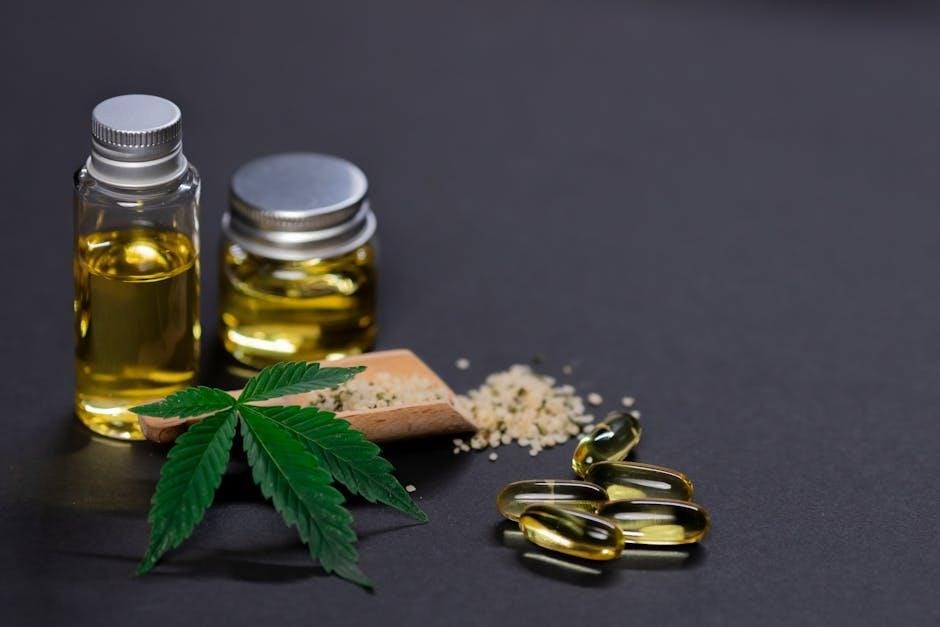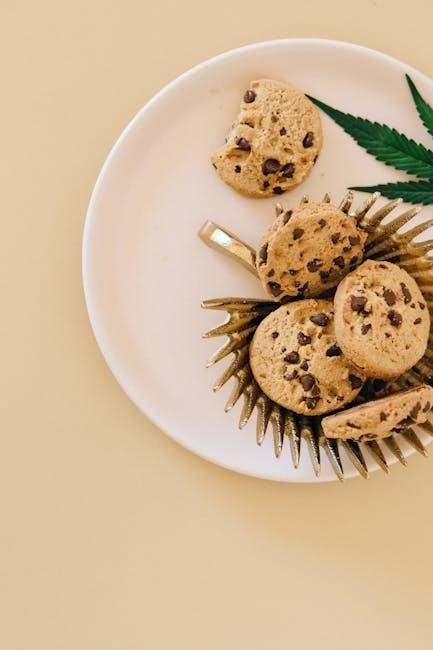Marijuana edibles are food or drink items infused with cannabis, offering a discreet and flavorful way to consume THC for recreational or medicinal purposes. Decarboxylation activates THC, making edibles potent. Easy-to-make at home, they allow customization of potency and ingredients, providing a convenient alternative to smoking.
1.1 What Are Marijuana Edibles?
Marijuana edibles are food or drink items infused with cannabis, offering a discreet and flavorful way to consume THC for recreational or medicinal purposes. Decarboxylation activates THC, making edibles potent. Easy-to-make at home, they allow customization of potency and ingredients, providing a convenient alternative to smoking.
1.2 Benefits of Making Edibles at Home
Making marijuana edibles at home offers numerous benefits, including customization of potency, flavors, and ingredients. It allows users to avoid additives found in commercial products, ensuring healthier options. Additionally, homemade edibles can be tailored to individual THC tolerance and dietary preferences. This method also saves money compared to purchasing pre-made edibles. With simple ingredients and tools, creating edibles at home is both cost-effective and empowering, providing a fun and creative cooking experience.
Understanding Cannabis and THC
Cannabis contains THC, the psychoactive compound responsible for its effects. THC interacts with the body’s endocannabinoid system, influencing mood, perception, and relaxation, making it central to edibles.
2.1 The Science Behind THC and Edibles
THC, the primary psychoactive compound in cannabis, interacts with the body’s endocannabinoid system when consumed. Edibles require digestion, where THC is absorbed and metabolized into 11-hydroxy-THC, a potent form with prolonged effects. Decarboxylation activates THC by converting it from THCA, its raw, non-psychoactive state. This process ensures edibles deliver consistent and powerful results, making understanding THC’s transformation crucial for crafting effective infused products.
2.2 Importance of Decarboxylation
Decarboxylation is a crucial step in making edibles, activating THC by converting non-psychoactive THCA into active THC. This process enhances potency and ensures edibles produce desired effects. Proper decarboxylation involves heating cannabis to specific temperatures, breaking down acidic compounds and maximizing THC availability. Skipping this step results in weak or ineffective edibles, making it essential for achieving optimal results in infused recipes.

Essential Ingredients and Tools
Key ingredients include cannabis, butter or oil, and flavor enhancers. Tools like slow cookers, strainers, and measuring cups are necessary for precise infusion and potency control.
3.1 Choosing the Right Cannabis Strain
Selecting the right cannabis strain is crucial for edibles, as different strains offer unique effects; Indica strains are relaxing, while sativa strains are uplifting. Hybrid strains provide a balanced experience. Consider THC and CBD levels for desired potency and effects. Higher THC strains create stronger edibles, while CBD-rich strains offer medicinal benefits without intense psychoactivity. Bud quality and aroma also impact flavor and potency, ensuring a superior edible experience. Choose strains based on personal preference and intended use for optimal results.
3.2 Carrier Ingredients: Butter vs. Oil
Butter and oil are the most common carriers for infusing cannabis, each offering unique benefits. Butter is traditional and enhances flavor, making it ideal for baked goods; Oil, particularly neutral-tasting options like coconut or olive oil, is versatile and suitable for both sweet and savory dishes. Butter provides a richer texture, while oil is better for dairy-free recipes. Both effectively bind THC, but butter has a shorter shelf life. Choose based on the recipe and desired texture for the best results in your edibles.
3.3 Necessary Kitchen Tools
To make marijuana edibles, essential kitchen tools include a grinder for preparing cannabis, a saucepan for infusing butter or oil, and a strainer to remove plant material. Measuring tools like a digital scale and spoons ensure accurate dosing. Baking supplies such as mixing bowls, whisks, and trays are also necessary. A double boiler can help maintain low temperatures during infusion, preventing cannabinoid degradation. Storage containers are crucial for keeping infused ingredients fresh. These tools streamline the process, ensuring consistency and potency in your edible creations.

Calculating THC Potency
Calculating THC potency involves determining the THC content of your cannabis, measuring the amount used, and dividing by the number of servings. This ensures accurate dosing for consistent effects in your edibles.
4.1 Step-by-Step Potency Calculation
To calculate the THC potency of edibles, start by determining the THC percentage in your cannabis flower. Next, measure the total amount of cannabis used in grams. Multiply this by the THC percentage to get total milligrams of THC. Then, divide this number by the total number of servings or portions your recipe yields. This will give you the THC content per serving, ensuring each edible is dosed accurately and consistently.
4.2 Dosage Guidelines for Edibles
Dosing edibles requires caution due to delayed effects. Start with a low dose of 5-10mg of THC per serving, especially for beginners. Allow 60-90 minutes for effects to manifest before considering another dose. Experienced users can gradually increase their intake, but always track THC content per serving. Consistency in potency calculation ensures safe and enjoyable consumption. Labeling edibles with dosage information is crucial to avoid overconsumption and enhance user experience. Always prioritize moderation and awareness of personal tolerance levels when consuming cannabis-infused products.
Infusing Cannabis into Butter and Oil
Infusing cannabis into butter or oil creates versatile bases for edibles. Melt butter or heat oil, add decarboxylated cannabis, and simmer to extract THC. Strain and store for later use in recipes.
5.1 Making Cannabis-Infused Butter
Making cannabis-infused butter is a simple process that starts with decarboxylating cannabis to activate THC. Grind the dried buds, bake at 220°F for 20-30 minutes, then melt butter in a saucepan. Add the decarboxylated cannabis, stir well, and simmer on low heat for 2-3 hours. Strain the mixture through a cheesecloth into a heat-proof container, pressing to extract all infused butter. Let it cool and solidify before using in recipes. This butter is a versatile base for baked goods, sauces, and other edibles.
5.2 Preparing Cannabis-Infused Oil
Preparing cannabis-infused oil involves decarboxylating dried cannabis buds in the oven at 220°F for 20-30 minutes. Grind the activated buds finely and combine with a neutral oil, like coconut or olive oil, in a saucepan. Simmer on low heat for 1-2 hours, stirring occasionally. Strain the mixture through a cheesecloth into a glass jar, discarding solids. Store the infused oil in a cool, dark place. Use this versatile oil for baking, dressings, or as a base for capsules, offering a discreet and efficient way to enjoy cannabis edibles.
Popular Edible Recipes
Classic cannabis cookies and potent marijuana brownies are timeless favorites, offering delicious ways to enjoy THC. These treats are easy to make and universally appealing, catering to both experienced cooks and beginners alike.
6.1 Classic Cannabis Cookies
Classic cannabis cookies are a beloved edible, combining simplicity with potency. Start by decarboxylating cannabis, then infuse it into butter or oil. Mix softened butter, sugar, eggs, and vanilla, blending in flour, baking powder, and salt. Fold in chocolate chips and cannabis-infused butter. Scoop dough onto a baking sheet and bake at 350°F for 10-12 minutes. Allow cookies to cool before serving. These treats are easy to customize with additional flavors like nuts or oats. Ensure proper dosage calculation for a consistent, enjoyable experience.
6.2 Potent Marijuana Brownies
Marijuana brownies are a classic edible, known for their rich flavor and potency. Begin by decarboxylating cannabis to activate THC. Infuse the cannabis into butter or oil, then mix with sugar, eggs, and vanilla. Combine flour, cocoa powder, and salt, blending wet and dry ingredients. Pour into a greased pan and bake at 350°F for 20-25 minutes. Let cool before cutting. For extra potency, use high-THC strains. Ensure dosage calculation for consistent effects, and store leftovers in an airtight container for freshness and safety.

Advanced Techniques for Edibles
Explore advanced techniques to elevate your edibles, from enhancing flavors to precise THC calculation. Create unique, potent treats with professional presentation.
7.1 Adding Flavor Enhancers
Elevate your edibles by incorporating diverse flavor enhancers like herbs, spices, and extracts. For instance, vanilla or citrus zest can mask cannabis taste, while cocoa enhances chocolate-based treats. Infusing butter or oil with garlic or herbs creates savory options. Additionally, using flavored oils or syrups allows for versatile recipes. Balancing flavors ensures your edibles are both delicious and potent, making them enjoyable for any palate.
7.2 Incorporating CBD for Balanced Effects
Incorporating CBD into your edibles offers a balanced experience by reducing THC’s psychoactive effects. CBD adds medicinal benefits like relaxation and pain relief without the euphoria. Start by infusing CBD-rich strains or mixing CBD isolate with THC. A 1:1 ratio is ideal for mild effects. This approach enhances therapeutic benefits while minimizing anxiety, making edibles more accessible for medicinal users seeking calm and comfort without intense highs.

Safety and Storage Tips
Properly store edibles in airtight containers, labeling them clearly. Keep them out of children’s reach and refrigerate for freshness. Consume responsibly and start with low doses to ensure a safe experience.
8.1 Proper Storage of Edibles
Store edibles in airtight, labeled containers to maintain freshness and prevent contamination. Keep them in a cool, dark place or refrigerate for longer shelf life. Ensure edibles are out of reach of children and pets. Proper labeling helps avoid accidental consumption. Freeze for extended storage, up to 6 months. Always check edibles for spoilage before consuming. Proper storage preserves potency and flavor, ensuring a safe and enjoyable experience.
8.2 Safety Precautions for Consumption
Start with low doses to assess tolerance, as edibles can have delayed effects. Avoid mixing with alcohol or other substances. Consume in a safe, comfortable environment. Keep edibles away from children and pets. Be aware of legal regulations and personal limits. If unsure, consult a healthcare professional. Overconsumption can lead to discomfort, so patience is key. Always prioritize responsible consumption for a positive experience.